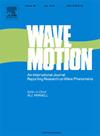Perturbation solution for second-harmonic generation in focused shear wave beams in soft solids
IF 2.5
3区 物理与天体物理
Q2 ACOUSTICS
引用次数: 0
Abstract
Plane nonlinear shear waves in isotropic media are subject only to cubic nonlinearity at leading order and therefore generate only odd harmonics during propagation. Wavefront curvature in shear wave beams breaks the symmetry in the material response and yields quadratic nonlinearity, such that a second harmonic may be generated at second order in a shear wave beam depending on the polarization of the wave field. The governing paraxial wave equation accounting for both quadratic and cubic nonlinearity in isotropic elastic media was derived originally by Zabolotskaya (1986), with its formulation employed in the present work developed subsequently by Wochner et al. (2008). Closed-form analytical solutions for the fields at the source frequency and the second harmonic are derived by perturbation for both the transverse and longitudinal particle displacement components in focused shear wave beams radiated by a source defined by affine polarization, Gaussian amplitude shading, and quadratic phase shading to account for focusing. Examples of field distributions are presented based on parameters reported by Cormack et al. (2024) for measurements of radially polarized focused shear wave beams generated in tissue-mimicking phantoms. Second-harmonic generation in shear wave beams with other polarizations is also discussed. Calculations are presented to estimate the vibration amplitude required for observable second-harmonic generation in tissue-mimicking phantoms. It is postulated that the second harmonic may be used to estimate the third-order elastic material property as an additional biomarker for diseased tissue.
软固体中聚焦剪切波束二次谐波产生的微扰解
平面非线性横波在各向同性介质中只服从三次非线性,因此在传播过程中只产生奇次谐波。剪切波束中的波前曲率破坏了材料响应的对称性,并产生二次非线性,从而在剪切波束中根据波场的极化可能产生二阶谐波。计算各向同性弹性介质中二次非线性和三次非线性的控制旁轴波动方程最初由Zabolotskaya(1986)导出,其公式随后由Wochner等人(2008)在本工作中发展。通过对由仿射偏振、高斯振幅遮光和二次相位遮光定义的源辐射的聚焦剪切波束的横向和纵向粒子位移分量的扰动,推导出源频率和二次谐波处场的封闭解析解。根据Cormack等人(2024)报告的参数,给出了场分布的例子,这些参数用于测量模拟组织幻象中产生的径向偏振聚焦剪切波束。此外,还讨论了其他极化的剪切波束中二次谐波的产生。计算提出了估计所需的振动幅度可观察到二次谐波产生的组织模拟的幽灵。假设二次谐波可用于估计三阶弹性材料特性,作为病变组织的附加生物标志物。
本文章由计算机程序翻译,如有差异,请以英文原文为准。
求助全文
约1分钟内获得全文
求助全文
来源期刊

Wave Motion
物理-力学
CiteScore
4.10
自引率
8.30%
发文量
118
审稿时长
3 months
期刊介绍:
Wave Motion is devoted to the cross fertilization of ideas, and to stimulating interaction between workers in various research areas in which wave propagation phenomena play a dominant role. The description and analysis of wave propagation phenomena provides a unifying thread connecting diverse areas of engineering and the physical sciences such as acoustics, optics, geophysics, seismology, electromagnetic theory, solid and fluid mechanics.
The journal publishes papers on analytical, numerical and experimental methods. Papers that address fundamentally new topics in wave phenomena or develop wave propagation methods for solving direct and inverse problems are of interest to the journal.
 求助内容:
求助内容: 应助结果提醒方式:
应助结果提醒方式:


